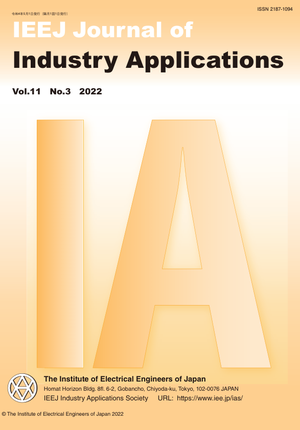Steady-State Analysis of Electric Machines Using the TP-EEC Method Based on Time-Periodic Conditions in a Rotational Reference Frame
Steady-State Analysis of Electric Machines Using the TP-EEC Method Based on Time-Periodic Conditions in a Rotational Reference Frame
カテゴリ: 論文誌(論文単位)
グループ名: 【D】産業応用部門(英文)
発行日: 2022/05/01
タイトル(英語): Steady-State Analysis of Electric Machines Using the TP-EEC Method Based on Time-Periodic Conditions in a Rotational Reference Frame
著者名: Hiroyuki Kaimori (Science Solutions International Laboratory, Inc./Department of Electrical Engineering & Bioscience, Graduate School of Advanced Science and Engineering, Waseda University), Yasuhito Takahashi (Faculty of Science and Engineering, Departme
著者名(英語): Hiroyuki Kaimori (Science Solutions International Laboratory, Inc./Department of Electrical Engineering & Bioscience, Graduate School of Advanced Science and Engineering, Waseda University), Yasuhito Takahashi (Faculty of Science and Engineering, Department of Electrical Engineering, Doshisha University), Shinji Wakao (Department of Electrical Engineering & Bioscience, Graduate School of Advanced Science and Engineering, Waseda University)
キーワード: dq rotational reference frame,finite-element method,steady-state analysis,time-periodic explicit-error-correction (TP-EEC) method,open-end winding
要約(英語): This paper proposes a new convergence acceleration method specialized for the magnetic field analyses of synchronous machines based on the time-periodic explicit-error-correction (TP-EEC) method. The proposed method constructs an auxiliary equation for error correction in the dq rotational reference frame to convert a fundamental harmonic component into a DC component. This conversion enables us to perform error correction using the TP-EEC method at intervals of an arbitrary number of time steps. The effective time intervals for error correction were investigated using practical interior permanent magnet synchronous motor (IPMSM) models. Moreover, DC superimposed problems, such as PMSMs with an open-end winding, were examined. Numerical results verified the effectiveness of the proposed method, and smaller time intervals could significantly improve the convergence characteristics of the transient analysis when high-order harmonic components were small. Furthermore, by adopting a 1/6 period as the time interval for the proposed method, a steady-state solution could be obtained precisely, even in a time-periodic problem that included many high-order harmonic components.
本誌: IEEJ Journal of Industry Applications Vol.11 No.3 (2022)
本誌掲載ページ: 458-466 p
原稿種別: 論文/英語
電子版へのリンク: https://www.jstage.jst.go.jp/article/ieejjia/11/3/11_21008445/_article/-char/ja/
受取状況を読み込めませんでした


